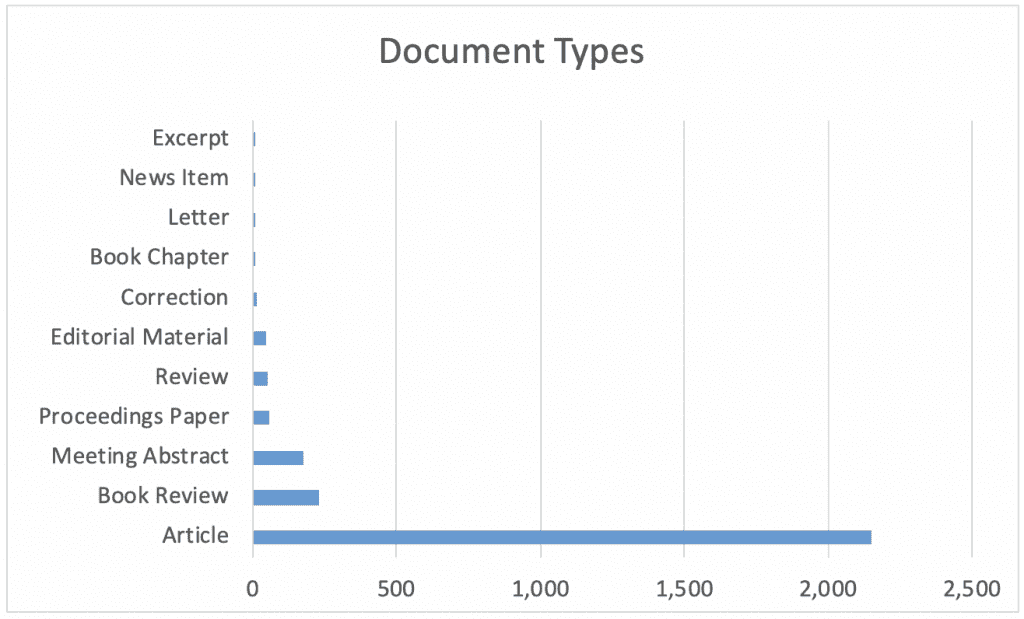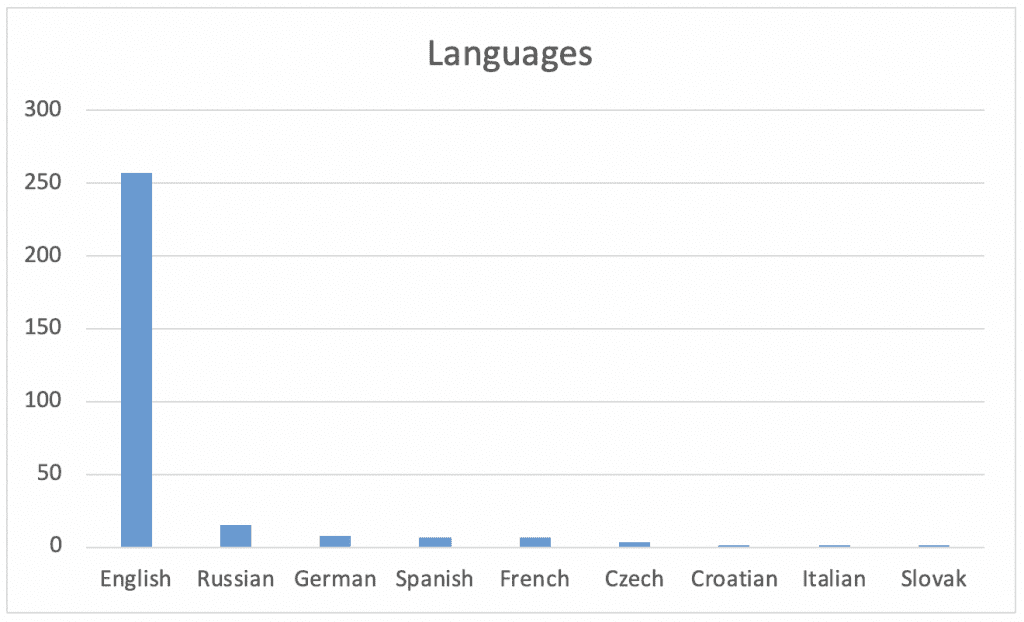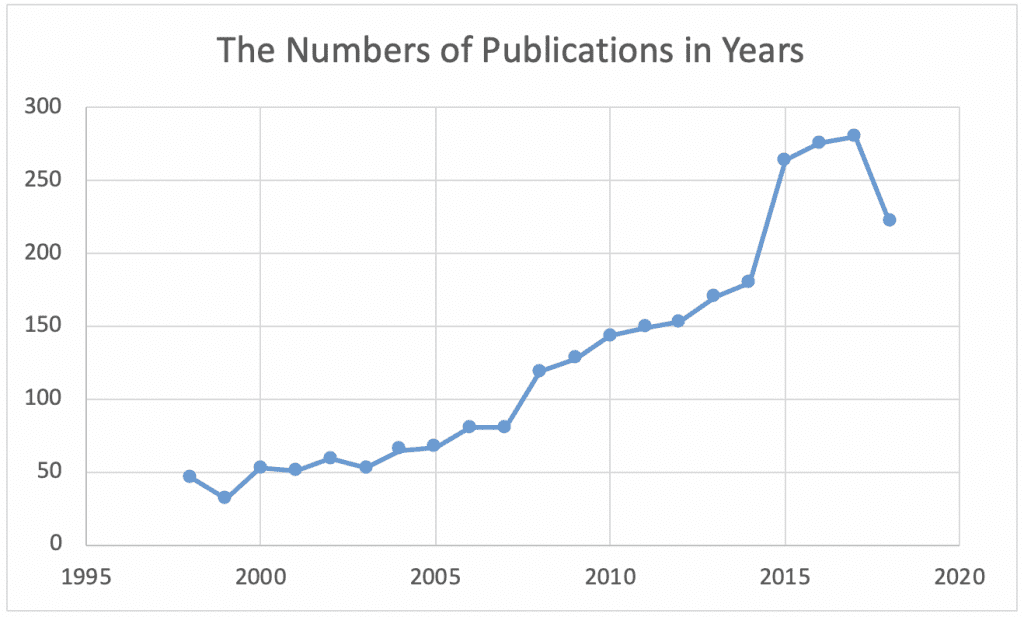Abstract
This research analyzed the literature on integration, assimilation, and other concepts[1] related to displaced persons[2] and refugees as experienced in their host countries. The author conducted a computer-assisted content analysis of related articles appearing in the Social Sciences Citation Index, Arts and Humanities Citation Index, Science Citation Index – Expanded, and Emerging Sources Citation Index and published from January of 1998 to September of 2018. The results of this research revealed that sociological articles comprised 11% of the academic studies (298 of 2,673). The results indicate that academic work regarding the integration of displaced persons encompasses many different concepts, dimensions, and approaches in a diverse collection of countries. Currently, there is no commonly held view of the meaning of integration or other related concepts. The current body of research focuses primarily on organizational and structural topics like housing, health, education, the labor force, identity, and language, instead of human-based topics such as social capital, community participation, and networks of displaced persons that recognize them as public actors (49 of 298 sociological articles). Integration studies of displaced persons almost doubled in number after 2015, the time of the most recent migrant crisis. This review argues that a common conceptual and theoretical framework needs to be put forward that expands the current body of research on human-based topics.
Keywords: Integration, assimilation, immigrants, refugees, social capital, literature analysis
Introduction
In the last two decades, the world has witnessed the greatest migration of displaced persons since the Second World War; the majority of displaced persons are from Asia and Africa. As of 2017, 64% of international migrants resided in high-income countries, primarily in the West (United Nations, 2017). Many nations have been affected by these recent changes, due to an influx at their borders and their efforts to meet their responsibilities under the 1967 UN Refugee Convention and its protocols. Political developments in this area have been followed by increased security and humanitarian concerns. As a result, the migrant crisis has become a top national priority, in recent years running in parallel with an increasing academic interest. While there is a relatively institutional understanding of migration in the Western world (Achiume, 2016), the conceptual consensus on terms like “integration” and “displaced persons” has yet to be properly structured (Korac, 2003).
The purpose of the study is to examine the most prestigious academic indexes for articles addressing the integration of displaced persons into host countries, in order to illustrate any conceptual confusion and identify common research perspectives and less-examined areas of analysis. This work focuses on the Thomson Reuters Web of Knowledge (WoK), Social Sciences Citation Index (SSCI), Arts and Humanities Citation Index (A&HCI), Science Citation Index – Expanded (SCI-EXPANDED), and Emerging Sources Citation Index (ESCI). After identifying the general body of academic studies, the author analyzed the content of the main sociological articles published in the last 20 years, including a content analysis of 257 articles published in English and abstract and/or key word analysis of 41 pieces published in other languages. Sociology was the most common academic discipline generating studies on the integration of displaced persons, followed by works considering demographics.
Conceptual Framework
Scholars have used many different terms to describe the settlement and reception process of displaced persons. Besides academics’ personal reasons for preferring certain terms, policy variances in specific countries have an effect on this multiplicity of concepts. Some research has stressed possible conceptual and practical reasons for this complexity and the resulting ambiguity (Korac, 2003). Most work has used integration (R. Alba, Sloan, & Sperling, 2011; Dribe & Lundh, 2008; Korac, 2003; Korteweg & Yurdakul, 2009; Van Oudenhoven & Eisses, 1998) and assimilation (R. D. Alba, Logan, Stults, Marzan, & Zhang, 1999; Harker, 2001; Safi, 2010; Stodolska, 1998; Waters & Jimenez, 2005) as substitute terms. Webster’s definition of “integrate” is “to form, coordinate, or blend into a functioning or unified whole, to unite with something else, to incorporate into a larger unit, and to end the segregation of and bring into equal membership in society or an organization” (Integrate, 2005). The “equal membership” element of this definition represents the mutual shares held by guests and hosts, though in practice the term differs among European countries. Webster’s defines “assimilate” as “to absorb into the cultural tradition of a population or group” (Assimilate, 2005). This term is predominantly used in American contexts and measured according to “socioeconomic status, spatial concentration, loss of mother tongue, and inter-marriage” (Waters & Jimenez, 2005). The notion of equal opportunity and American immigration practices may have an effect on the common use of the term in American contexts. The term “segmented assimilation” refers to post-1965 America. It differs from classical assimilation, which locates displaced persons’ success in their “assimilate[ion] [in]to mainstream culture” (St-Hilaire, 2002).
The related literature uses additional concepts to define the settlement and reception process of displaced persons in and by host countries. These concepts can be divided into acculturation (Berry & Sabatier, 2010; Gerhards & Hans, 2009; Kosic, Mannetti, & Sam, 2005; Navas, Rojas, Garcia, & Pumares, 2007; Neto, 2002), adaptation (Hofstra, van Oudenhoven, & Buunk, 2005; Portes, Haller, & Guarnizo, 2002; St-Hilaire, 2002; Vedder & Virta, 2005), adjustment (Bobowik, Basabe, & Paez, 2014; Markovic & Manderson, 2000; Portes & Hao, 2002; Zlobina, Basabe, Paez, & Furnham, 2006), segmented assimilation (de Graaf & van Zenderen, 2009; Sassler, 2006; Segeritz, Walter, & Stanat, 2010; Vermeulen, 2010; Zhou & Xiong, 2005), transnationalism (Al-Ali, Black, & Koser, 2001; Caglar, 2006; Landolt, 2001; Portes et al., 2002), orientation (Bernard, 2006; Magnan, Grenier, & Darchinian, 2015; Rubin, Watt, & Ramelli, 2012), multiculturalism (Gieling, Thijs, & Verkuyten, 2011; Koopmans & Statham, 1999; Leong & Ward, 2006; Schalk-Soekar, de Vijver, & Hoogsteder, 2004), and enculturation (Weinreich, 2009). Acculturation refers to the “cultural modification of people by adapting to or borrowing traits from another culture,” while enculturation is associated with one’s own culture (Acculturation, 2005). Webster’s summarizes the main differences between assimilation and acculturation as follows:
Acculturation is often tied to political conquest or expansion, and is applied to the process of change in beliefs or traditional practices that occurs when the cultural system of one group displaces that of another. Assimilation refers to the process through which individuals and groups of differing heritages acquire the basic habits, attitudes, and mode of life of an embracing culture. (Acculturation, 2005).
The terms adaptation, adjustment, and orientation were used similarly in these studies. They generally showed the transition process from the old environment and/or condition to the new. Transnationalism and multiculturalism are related to diversity. Conversely, the reverse meanings include discrimination (Jasinskaja-Lahti, Liebkind, & Perhoniemi, 2007; Noh, Beiser, Kaspar, Hou, & Rummens, 1999; Roder & Muhlau, 2011; Stevens, Hussein, & Manthorpe, 2012), segregation (Catanzarite, 2000; Driedger, 1999; Khazzoom, 2005; Park & Iceland, 2011), and isolation (Cherng, 2015; Nawyn, Gjokaj, Agbenyiga, & Grace, 2012; van Hook & Baker, 2010). These negative concepts refer to the inequality between displaced persons and residents of host countries.
Methodology
The author accessed the WoK, SSCI, A&HCI, SCI-EXPANDED, and ESCI databases through an American research university in July and August of 2018, and via the advanced search option, examined the academic studies most related to displaced persons’ experiences in their host countries. Migrant, immigrant, and refugee were the base search terms used. Concepts such as integration, assimilation, acculturation, adaptation, adjustment, segmented assimilation, transnationalism, orientation, multiculturalism, and enculturation were employed to identify positive points in the literature, while discrimination, segregation, and isolation were searched to unearth the negative. The vocabulary groups consisted of combinations of integration and displaced person-related terms in the study titles (e.g., integration migrant, acculturation refugee, etc.). The date range was limited to January 1998 through September 2018. After a general evaluation of the academic studies, the field of sociology was selected so that the current research would have a consistent focus. The 298 articles constituting the basis of this research were classified according to the language of publication. While the 257 articles written in English were subjected to a complete content analysis, the 41 written in other languages were analyzed from their English-language abstracts. Finally, the research question was classified, analyzed, and visualized.
Findings and Analyses
A total of 2,673 academic works published between January 1998 and September 2018 were found in the SSCI, A&HCI, SCI-EXPANDED, and ESCI databases. These articles constituted 80% of the greater body of academic studies. Book reviews and conference abstracts followed (see Table 1). When the articles were examined according to research category, sociology and demography were the first two subjects and very close in number. These two research categories comprised 28% of the greater body of publications (see Table 2). More than 90% were written in English.

Table 1. Document types

Table 2. Article categories
Academic articles on the integration of displaced persons that were published in the field of sociology – the focal point of the current research – accounted for 11% of the total number of academic studies and 14% of all articles (298 of 2,149). When the studies were classified by language, it was found that 83% were written in English (see Table 3).

Table 3. Publication languages
The annual distribution of academic articles published from 1998 to 2005 did not exceed 50; there were between 50 and 100 published from 2005 to 2009 and 100 to 150 from 2009 through 2014. From 2015 through September of 2018, the number of articles published was approximately 200. It is possible that more than 200 articles will be published in this date range; more are likely to appear in the four months of 2018 following the creation of the trend graph. A harmony was found between change per year and increase in the number of displaced persons worldwide (see Tables 4a and b).

Table 4a. Publications by year

Table 4b. International migration (in millions)
The sociological studies concentrated more on tangible topics (64%) such as housing, health, education, labor, identity, and language. Human-based topics made up a smaller group (16%) and addressed issues such as social capital, community participation, and shared networks.
Conclusions and Discussion
Most studies focused on tangible and measurable material issues. A likely reason for this is that the data can be easily obtained. These studies dealt with issues from a single point of view, either that of the displaced group or residents of the host country. The focus was mainly on immigrants’ basic needs, such as housing, health care, participation in the labor force, language acquisition, and education, as provided through the reception and settlement process. Information about how many people became employed; received social services such as education, health care, and housing; and learned the local language is easily accessed from aid institutions, and therefore it is a simple process to measure such issues and assess them scientifically.
Another significant topic was migrant identity. In particular, ethnic issues such as gender, age, and a sense of belonging were examined. Researchers appeared to attribute immigrants/refugees a common identity and not consider them individual human beings. A common approach was to assess the impacts and consequences of policies applied to a particular group in a given host country. There were two main forms of integration policy: (1) pluralistic, multicultural, flexible, and soft; and (2) rigid and assimilation-based. A common finding was that sufficient success was not being achieved; displaced people were not fully able to participate in society and instead tended to be isolated in their own neighborhoods.
Conversely, there were several studies that considered immigrants to be social actors and examined their relationships, social networks, and community participation in the host country; these comprised 49 of the 298 articles and 16% of the total number of studies. After Putman developed and conceptualized social capital theory, research in that field increased. Instead of a one-way approach, these studies adopted a bilateral method that included both residents of the host country and displaced people. Such articles emphasized intangible issues such as trust, respect, and equality between migrants and residents, rather than material issues such as health, housing, language, and education. The relationships, social networks, and community participation of migrants and residents were the most common measurement parameters. Of the total, 27% of the studies (81 articles) could be categorized as social psychology. This illustrates that the human-based approach to integration is not sufficient, but is improving.
There are many different approaches to and policies regarding the integration of displaced people. The complexity and ambiguity of the topic are not only conceptual but also practical. There is no common method for or notion of integration. Tangible and emotional issues should be examined together when developing integration policies. Future studies should endeavor to provide conceptual unity and examine the material and moral issues as a unified whole.
References
Acculturation. (2005). In Merriam-Webster’s dictionary (11th ed.). Springfield, MA: Merriam-Webster.
Achiume, E. T. (2016). Syria, Cost-sharing, and the Responsibility to Protect Refugees. Minnesota Law Review, 100(2), 687-761.
Al-Ali, B., Black, R., & Koser, K. (2001). The limits to ‘transnationalism’: Bosnian and Eritrean refugees in Europe as emerging transnational communities. Ethnic and Racial Studies, 24(4), 578-600.
Alba, R., Sloan, J., & Sperling, J. (2011). The Integration Imperative: The Children of Low-Status Immigrants in the Schools of Wealthy Societies. In K. S. Cook & D. S. Massey (Eds.), Annual Review of Sociology, Vol 37 (Vol. 37, pp. 395-415).
Alba, R. D., Logan, J. R., Stults, B. J., Marzan, G., & Zhang, W. Q. (1999). Immigrant groups in the suburbs: A reexamination of suburbanization and spatial assimilation. American Sociological Review, 64(3), 446-460. doi:10.2307/2657495
Assimilate. (2005). In Merriam-Webster’s dictionary (11th ed.). Springfield, MA: Merriam-Webster.
Bernard, J. (2006). The social integration of migrants from cities to villages in the Czech Republic and in Austria. Sociologicky Casopis-Czech Sociological Review, 42(4), 741-760.
Berry, J. W., & Sabatier, C. (2010). Acculturation, discrimination, and adaptation among second generation immigrant youth in Montreal and Paris. International Journal of Intercultural Relations, 34(3), 191-207. doi:10.1016/j.ijintrel.2009.11.007
Bobowik, M., Basabe, N., & Paez, D. (2014). “Heroes of adjustment”: Immigrant’s stigma and identity management. International Journal of Intercultural Relations, 41, 112-124. doi:10.1016/j.ijintrel.2014.04.002
Caglar, A. (2006). Hometown associations, the rescaling of state spatiality and migrant grassroots transnationalism. Global Networks-a Journal of Transnational Affairs, 6(1), 1-22. doi:10.1111/j.1471-0374.2006.00130.x
Catanzarite, L. (2000). Brown-collar jobs: Occupational segregation and earnings of recent-immigrant Latinos. Sociological Perspectives, 43(1), 45-75. doi:10.2307/1389782
Cherng, H. Y. S. (2015). Social Isolation Among Racial/Ethnic Minority Immigrant Youth. Sociology Compass, 9(6), 509-518. doi:10.1111/soc4.12276
de Graaf, W., & van Zenderen, K. (2009). Segmented assimilation in the Netherlands? Young migrants and early school leaving. Ethnic and Racial Studies, 32(8), 1470-1488. doi:10.1080/01419870902763860
Dribe, M., & Lundh, C. (2008). Intermarriage and Immigrant Integration in Sweden An Exploratory Analysis. Acta Sociologica, 51(4), 329-354. doi:10.1177/0001699308097377
Driedger, L. (1999). Immigrant/ethnic/racial segregation: Canadian big three and prairie metropolitan comparison. Canadian Journal of Sociology-Cahiers Canadiens De Sociologie, 24(4), 485-509. doi:10.2307/3341788
Gerhards, J., & Hans, S. (2009). From Hasan to Herbert: Name-Giving Patterns of Immigrant Parents between Acculturation and Ethnic Maintenance. American Journal of Sociology, 114(4), 1102-1128. doi:10.1086/595944
Gieling, M., Thijs, J., & Verkuyten, M. (2011). Voluntary and involuntary immigrants and adolescents’ endorsement of multiculturalism. International Journal of Intercultural Relations, 35(2), 259-267. doi:10.1016/j.ijintrel.2010.09.003
Harker, K. (2001). Immigrant generation, assimilation, and adolescent psychological well-being. Social Forces, 79(3), 969-1004. doi:10.1353/sof.2001.0010
Hofstra, J., van Oudenhoven, J. P., & Buunk, B. P. (2005). Attachment styles and majority members’ attitudes towards adaptation strategies of immigrants. International Journal of Intercultural Relations, 29(5), 601-619. doi:10.1016/j.ijintrel.2005.05.009
Integrate. (2005). In Merriam-Webster’s dictionary (11th ed.). Springfield, MA: Merriam-Webster.
Jasinskaja-Lahti, I., Liebkind, K., & Perhoniemi, R. (2007). Perceived ethnic discrimination at work and well-being of immigrants in Finland: The moderating role of employment status and work-specific group-level control beliefs. International Journal of Intercultural Relations, 31(2), 223-242. doi:10.1016/j.ijintrel.2006.02.003
Khazzoom, A. (2005). Did the Israeli state engineer segregation? On the placement of Jewish immigrants in development towns in the 1950s. Social Forces, 84(1), 115-134. doi:10.1353/sof.2005.0106
Koopmans, R., & Statham, P. (1999). Challenging the liberal nation-state? Postnationalism, multiculturalism, and the collective claims making of migrants and ethnic minorities in Britain and Germany. American Journal of Sociology, 105(3), 652-696. doi:10.1086/210357
Korac, M. (2003). Integration and how we facilitate it: A comparative study of the settlement experiences of refugees in Italy and the Netherlands. Sociology-the Journal of the British Sociological Association, 37(1), 51-68. doi:10.1177/0038038503037001387
Korteweg, A., & Yurdakul, G. (2009). Islam, gender, and immigrant integration: boundary drawing in discourses on honour killing in the Netherlands and Germany. Ethnic and Racial Studies, 32(2), 218-238. doi:10.1080/01419870802065218
Kosic, A., Mannetti, L., & Sam, D. L. (2005). The role of majority attitudes towards out-group in the perception of the acculturation strategies of immigrants. International Journal of Intercultural Relations, 29(3), 273-288. doi:10.1016/j.ijintrel.2005.06.004
Landolt, P. (2001). Salvadoran economic transnationalism: embedded strategies for household maintenance, immigrant incorporation, and entrepreneurial expansion. Global Networks-a Journal of Transnational Affairs, 1(3), 217-241. doi:10.1111/1471-0374.00014
Leong, C. H., & Ward, C. (2006). Cultural values and attitudes toward immigrants and multiculturalism: The case of the Eurobarometer survey on racism and xenophobia. International Journal of Intercultural Relations, 30(6), 799-810. doi:10.1016/j.ijintrel.2006.07.001
Magnan, M. O., Grenier, V., & Darchinian, F. (2015). STRATEGIES OF ORIENTATION AND PROFESSIONAL INSERTION OF YOUNG IMMIGRANT IN MONTREAL : MOTIVES OF CHOICE OF ENGLISH-SPEAKING AND FRENCH-SPEAKING POST SECONDARY INSTITUTIONS. Canadian Journal of Sociology-Cahiers Canadiens De Sociologie, 40(4), 501-525.
Markovic, M., & Manderson, L. (2000). Nowhere is as at home: adjustment strategies of recent immigrant women from the former Yugoslav Republics in southeast Queensland. Journal of Sociology, 36(3), 315-328. doi:10.1177/144078330003600303
Navas, M., Rojas, A. J., Garcia, M., & Pumares, P. (2007). Acculturation strategies and attitudes according to the Relative Acculturation Extended Model (RAEM): The perspectives of natives versus immigrants. International Journal of Intercultural Relations, 31(1), 67-86. doi:10.1016/j.ijintrel.2006.08.002
Nawyn, S. J., Gjokaj, L., Agbenyiga, D. L., & Grace, B. (2012). Linguistic Isolation, Social Capital, and Immigrant Belonging. Journal of Contemporary Ethnography, 41(3), 255-282. doi:10.1177/0891241611433623
Neto, F. (2002). Acculturation strategies among adolescents from immigrant families in Portugal. International Journal of Intercultural Relations, 26(1), 17-38. doi:10.1016/s0147-1767(01)00036-0
Noh, S., Beiser, M., Kaspar, V., Hou, F., & Rummens, J. (1999). Perceived racial discrimination, depression, and coping: A study of Southeast Asian refugees in Canada. Journal of Health and Social Behavior, 40(3), 193-207. doi:10.2307/2676348
Park, J., & Iceland, J. (2011). Residential segregation in metropolitan established immigrant gateways and new destinations, 1990-2000. Social Science Research, 40(3), 811-821. doi:10.1016/j.ssresearch.2010.10.009
Portes, A., Haller, W. J., & Guarnizo, L. E. (2002). Transnational entrepreneurs: An alternative form of immigrant economic adaptation. American Sociological Review, 67(2), 278-298. doi:10.2307/3088896
Portes, A., & Hao, L. X. (2002). The price of uniformity: language, family and personality adjustment in the immigrant second generation. Ethnic and Racial Studies, 25(6), 889-912. doi:10.1080/0141987022000009368
Roder, A., & Muhlau, P. (2011). DISCRIMINATION, EXCLUSION AND IMMIGRANTS’ CONFIDENCE IN PUBLIC INSTITUTIONS IN EUROPE. European Societies, 13(4), 535-557. doi:10.1080/14616696.2011.597869
Rubin, M., Watt, S. E., & Ramelli, M. (2012). Immigrants’ social integration as a function of approach-avoidance orientation and problem-solving style. International Journal of Intercultural Relations, 36(4), 498-505. doi:10.1016/j.ijintrel.2011.12.009
Safi, M. (2010). Immigrants’ Life Satisfaction in Europe: Between Assimilation and Discrimination. European Sociological Review, 26(2), 159-176. doi:10.1093/esr/jcp013
Sassler, S. L. (2006). School participation among immigrant youths: The case of segmented assimilation in the early 20th century. Sociology of Education, 79(1), 1-24.
Schalk-Soekar, S. R. G., de Vijver, F., & Hoogsteder, M. T. (2004). Attitudes toward multiculturalism of immigrants and majority members in the Netherlands. International Journal of Intercultural Relations, 28(6), 533-550. doi:10.1016/j.ijintrel.2005.01.009
Segeritz, M., Walter, O., & Stanat, P. (2010). Patterns of educational success of immigrant students in Germany: Evidence of segmented assimilation? Kolner Zeitschrift Fur Soziologie Und Sozialpsychologie, 62(1), 113-138. doi:10.1007/s11577-010-0094-1
St-Hilaire, A. (2002). The social adaptation of children of Mexican immigrants: Educational aspirations beyond junior high school. Social Science Quarterly, 83(4), 1026-1043. doi:10.1111/1540-6237.00131
Stevens, M., Hussein, S., & Manthorpe, J. (2012). Experiences of racism and discrimination among migrant care workers in England: Findings from a mixed-methods research project. Ethnic and Racial Studies, 35(2), 259-280. doi:10.1080/01419870.2011.574714
Stodolska, M. (1998). Assimilation and leisure constraints: Dynamics of constraints on leisure in immigrant populations. Journal of Leisure Research, 30(4), 521-551.
United Nations, Department of Economic and Social Affairs, Population Division (2017). International Migration Report 2017: Highlights (ST/ESA/SER.A/404).
van Hook, J., & Baker, E. (2010). Big Boys and Little Girls: Gender, Acculturation, and Weight among Young Children of Immigrants. Journal of Health and Social Behavior, 51(2), 200-214. doi:10.1177/0022146510372347
Van Oudenhoven, J. P., & Eisses, A. M. (1998). Integration and assimilation of Moroccan immigrants in Israel and the Netherlands. International Journal of Intercultural Relations, 22(3), 293-307.
Vedder, P., & Virta, E. (2005). Language, ethnic identity, and the adaptation of Turkish immigrant youth in the Netherlands and Sweden. International Journal of Intercultural Relations, 29(3), 317-337. doi:10.1016/j.ijintrel.2005.05.006
Vermeulen, H. (2010). Segmented assimilation and cross-national comparative research on the integration of immigrants and their children. Ethnic and Racial Studies, 33(7), 1214-1230. doi:10.1080/01419871003615306
Waters, M. C., & Jimenez, T. R. (2005). Assessing immigrant assimilation: New empirical and theoretical challenge. In Annual Review of Sociology (Vol. 31, pp. 105-125).
Weinreich, P. (2009). ‘Enculturation’, not ‘acculturation’: Conceptualising and assessing identity processes in migrant communities. International Journal of Intercultural Relations, 33(2), 124-139. doi:10.1016/j.ijintrel.2008.12.006
Zhou, M., & Xiong, Y. S. (2005). The multifaceted American experiences of the children of Asian immigrants: Lessons for segmented assimilation. Ethnic and Racial Studies, 28(6), 1119-1152. doi:10.1080/01419870500224455
Zlobina, A., Basabe, N., Paez, D., & Furnham, A. (2006). Sociocultural adjustment of immigrants: Universal and group-specific predictors. International Journal of Intercultural Relations, 30(2), 195-211. doi:10.1016/j.ijintrel.2005.07.005
*Cihan Aydiner is a PhD Candidate in Sociology at Louisiana State University and non-resident research fellow at Beyond the Horizon ISSG. ↑

